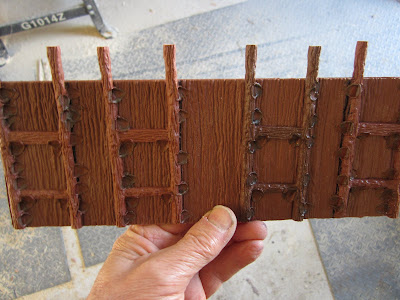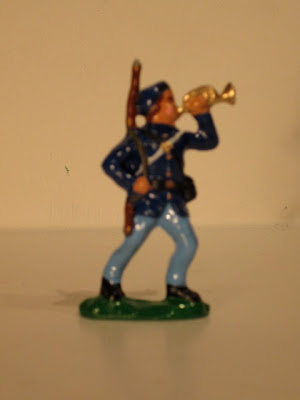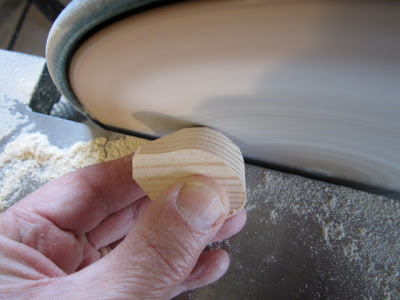.
An idea has been churning around in my head for some time though its been far below the surface. Suddenly I found myself aware of, and acting upon it; a larger surface, in the house, upon which to photograph, and play with, toy soldiers. Time to head out to the shop.
I figured out the materials on paper and drew up a plan, then it was time to power-up the table saw and start cutting.
The table is designed to fit in an unused corner of the furnace room. The available space is about four feet by seven and a half.
All that remains is to brace the legs, and to start building topographic elements - things for soldiers to hide behind!
Band-saw and sander (with extra coarse belt) teamed up to make some cool artillery lunettes.
Back to the sander to use the disc to transform odd pieces of 2"x4" into boulders.
Things are shaping up, with stone ridges, boulders, and terrain features.
For the most part this was all done using scrap wood that I just had lying around. All of the hills are stepped, ziggurat-style, to allow soldiers to appear to be climbing them.
The pieces were cut and stacked for a large hill. This was the only feature which had the layers permanently glued and clamped.
Hey, you use your clamps, I'll use mine.
Here's one version of how this strategic point can be utilized.
Now came painting and texturing.
For texture on most of the pieces I liberally brushed carpenters glue all over the surfaces and then sprinkled fine sawdust all over the wet glue.
This process is really easy and way cheaper than buying hobby-shop flocking.
Texture applied...
its time to paint.
Things are starting to take shape.
I cut a creek out of a sheet of Plexiglas and reverse-painted a creek on it.
Now came time to paint a backdrop.
I used the James Hope paintings at Antietam National Battlefield for guidance.
Using acrylics I got started. Getting a nice gradation of blue for the sky was actually the hardest part.
The backdrop took about six hours to paint. Then I shoved the table back into position and started placing the various elements.
All pieces, save for the largest hill, have separate layers...
providing a variety of combinations.
With the paint barely dry and as the last element was put into place the troops started arriving on the field.

Artillery was well-represented and putting the lunettes to effective use.
A sentinel on the high ground surveys the arrival of the army.
In the valley below he sees the cloud of dust as cavalry thunder across the otherwise peaceful creek
Ancient boulders sit impassive to the machinations of man.
A signal station is established on a high prominence.
More artillery is rushed to the scene. One can only imagine the outcome.
An outcome that may be the fodder of a later post.
Here it is, a nice, warm, dry place to play the winter away. Total time to make this was two weekends and a few evenings in between.
This is a work in progress. Right now I'm working on a road, lane, more terrain, and a railroad bed, and more trees as well. I'll be posting more as things continue to evolve. Do tune in.
The more things change...
the more they stay the same.
Soldier on!
Mannie
.























































